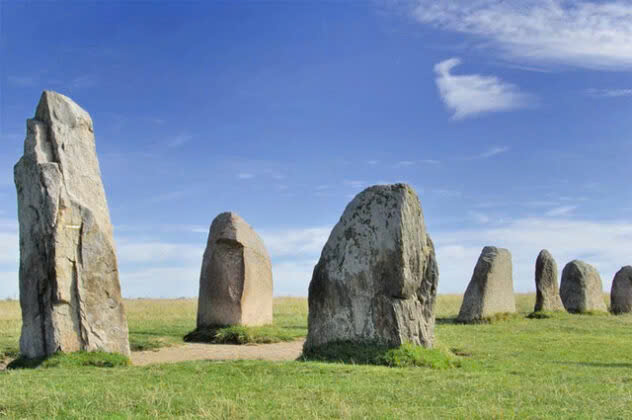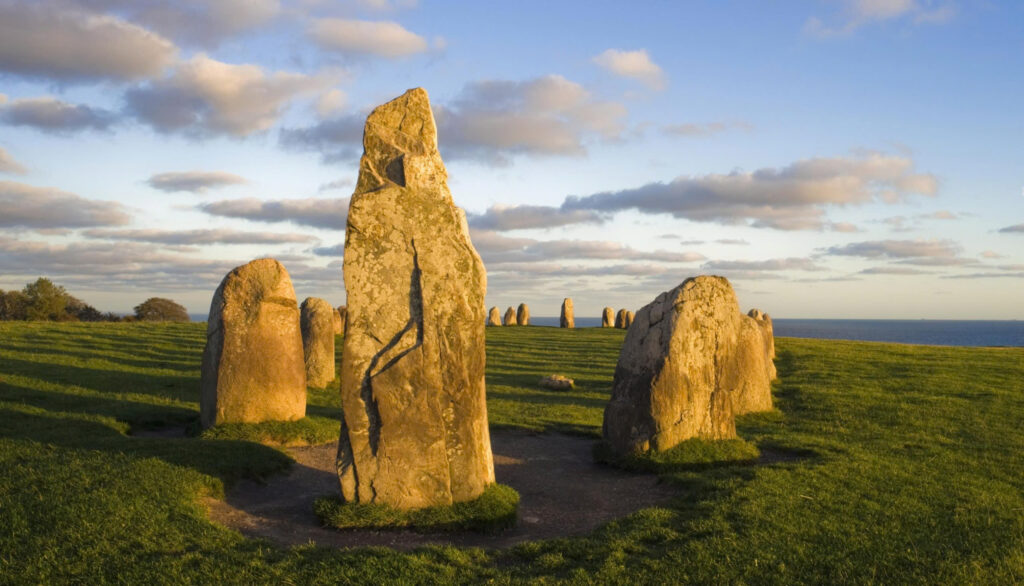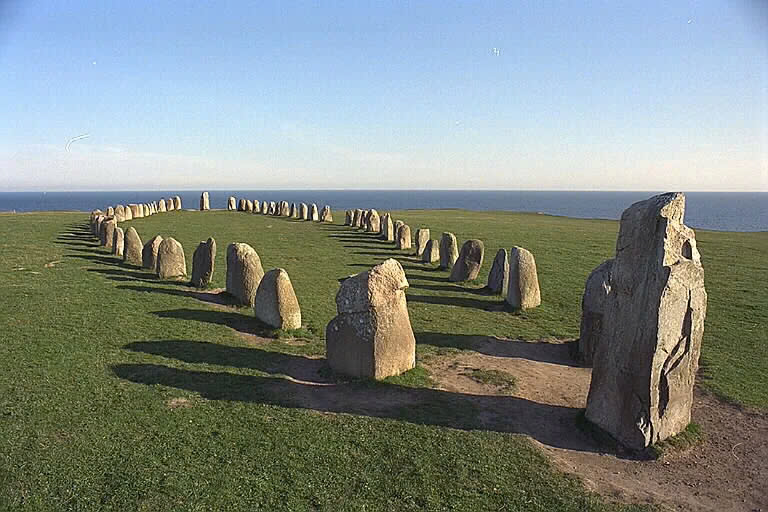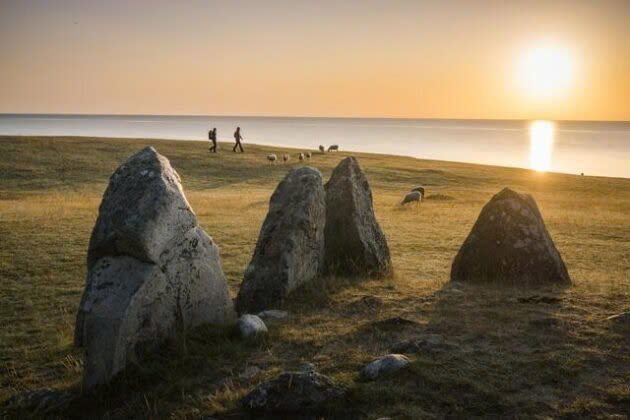Sweden’s coastal region of Scania harbors one of Scandinavia’s most captivating archaeological mysteries. Perched dramatically on a hillside overlooking the Baltic Sea stands Ale’s Stones—an imposing megalithic monument that has puzzled and fascinated researchers for generations. Often called “Sweden’s Stonehenge,” this ancient stone ship carries with it tales of gods, astronomy, and forgotten knowledge that continue to intrigue modern visitors.
The Seafaring Monument: Structure and Setting
Commanding the windswept hills near the fishing village of Kåseberga, Ale’s Stones makes an unforgettable impression on all who visit. Fifty-nine massive boulders—some weighing nearly two tons—form a perfect ship-shaped outline stretching 67 meters in length and 19 meters at its widest point. The precision of its elliptical formation speaks to the engineering skill of its creators, especially considering these massive stones were transported from quarries up to 30 kilometers away using nothing but primitive tools, sleds, and human determination.

The monument’s strategic position affords breathtaking panoramic views across Österlen’s rolling landscape and the endless horizon of the Baltic Sea. This spectacular setting only enhances the site’s mystical atmosphere, making it easy to understand why ancient peoples would have chosen this location for a monument of such significance.
Riddles of Time: Dating Controversies and Cultural Context
The true age of Ale’s Stones remains one of its most contested aspects. Archaeological evidence presents a complex timeline, with carbon dating suggesting origins potentially reaching back 5,500 years to the Neolithic era. However, other findings point to the Nordic Iron Age (500-1000 AD), with indications that earlier Bronze Age structures may have been incorporated or repurposed.

The name itself—”Ale”—is thought to derive from ancient Nordic words meaning “sanctuary,” hinting at the site’s possible sacred nature. Local legends speak of a mythical king buried within the formation, his spirit eternally watching over seafarers navigating the Baltic waters. These stories reflect the strong maritime traditions that shaped life in coastal Scandinavia for millennia.
Ship Symbolism in Nordic Culture
The distinctive ship shape of Ale’s Stones carries profound symbolic weight in ancient Nordic belief systems. Ships represented not only the practical lifeblood of coastal communities but also served as powerful spiritual metaphors for life’s journey and the passage to the afterlife. Many scholars believe the monument may have commemorated fallen warriors or served as a symbolic vessel to carry departed souls into the next world.

Similar stone ship formations appear throughout Scandinavia, suggesting these monuments formed part of shared cultural and religious practices across the region. The weathered cup marks visible on some stones—a form of prehistoric art common in Bronze Age Scandinavia—further emphasize the ritual significance of the site.
Celestial Connections: A Stone Calendar Written in Sunlight
Perhaps the most compelling evidence of Ale’s Stones’ sophisticated purpose lies in its precise astronomical alignments. Researchers have documented how the monument aligns perfectly with the sun’s movements during the solstices—at summer solstice, the sun sets at the northwestern corner, while at winter solstice, it rises at the southeastern end.

These alignments suggest the monument functioned as an astronomical calendar, allowing ancient communities to track seasonal changes crucial for agricultural planning. Archaeological discoveries of hearths and evidence of fires near the site indicate it likely hosted solstice celebrations and community gatherings, connecting people to the rhythms of nature that governed their lives.
Global Perspectives: Ale’s Stones in Wider Context
Some researchers, including retired Swedish geologist Nils-Axel Mörner, have proposed fascinating connections between Ale’s Stones and other ancient monuments. Mörner’s controversial theories suggest the site shares design principles with England’s Stonehenge, potentially indicating knowledge exchange between prehistoric societies across Europe.

While academic debate continues, these theories highlight an important truth: Bronze Age Scandinavian communities were not isolated. They participated in extensive trade networks and cultural exchanges spanning Europe and beyond. The sophisticated knowledge embedded in monuments like Ale’s Stones testifies to the intellectual accomplishments of these supposedly “primitive” societies.
Modern Interpretations: Science, Spirituality, and Popular Culture
Today, Ale’s Stones continues to inspire multiple interpretations. Academic archaeologists generally view it as a grave marker or calendar with strong cultural and astronomical significance. Martin Rundkvist and other scholars emphasize its likely function as a memorial to Iron Age seafarers, consistent with similar monuments throughout the region.

Meanwhile, alternative perspectives abound. New Age spiritual seekers often attribute mystical properties to the stones, regarding them as energy centers or portals to ancient wisdom. While such interpretations lack scientific support, they speak to the monument’s enduring power to captivate the imagination and connect visitors to something beyond everyday experience.
Video
Experiencing Ale’s Stones: A Journey Through Time
For modern visitors, Ale’s Stones offers a profound encounter with the past. The site remains refreshingly undeveloped, allowing travelers to experience the monument much as people would have centuries ago. Walking among the massive stones while gazing out over the Baltic creates a palpable connection to those who stood in the same spot thousands of years before.

Accessible from the nearby town of Ystad, Ale’s Stones makes an ideal destination for history enthusiasts, photographers, and anyone seeking to experience Sweden beyond its urban centers. The surrounding area offers excellent hiking opportunities and glimpses into Scania’s distinctive cultural heritage.
The Enduring Mystery: Why We Remain Fascinated
Despite decades of research, Ale’s Stones retains much of its mystery. Was it primarily a burial monument, an astronomical observatory, a gathering place for religious ceremonies, or some combination of these? The definitive answer remains elusive, and perhaps this very uncertainty contributes to its lasting appeal.

What’s clear is that Ale’s Stones represents far more than a random arrangement of boulders. It stands as eloquent testimony to the sophistication, spiritual depth, and astronomical knowledge of ancient Nordic peoples. In our technology-saturated modern world, such ancient monuments remind us that our ancestors possessed forms of wisdom and understanding that we are still working to fully comprehend.
As you stand among these silent stones with the wind from the Baltic Sea washing over you, it’s impossible not to feel a profound connection—not just to Sweden’s past, but to humanity’s eternal quest to understand our place in the cosmos and leave meaningful marks upon the world.

